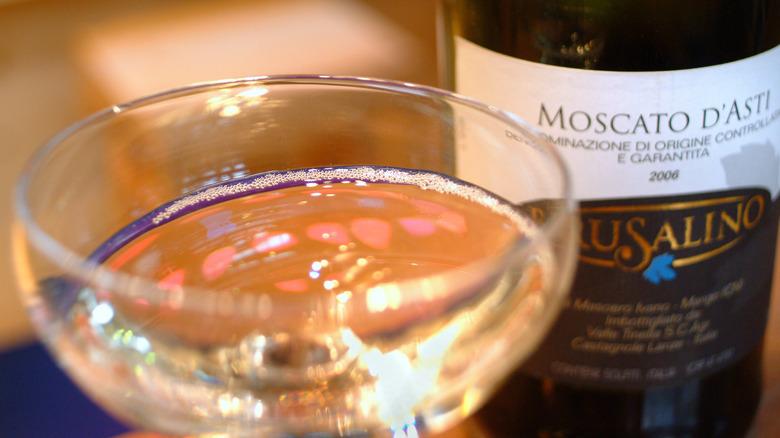Muscadet And Moscato Are Not As Similar As They Sound
However you choose to pronounce the word tomato, you'll end up with the same juicy, red veggie. However, with Muscadet and Moscato it's not that easy: Despite the names having a similar ring, these two wines are nothing alike.
While both are types of white wine and typically have a light golden color, the flavor and mouthfeel of the two wines are much different. If you take a sip of Muscadet when you're expecting Moscato, your taste buds will be in for a big surprise. The dry, crisp, and even briny notes of Muscadet make it a favorite to enjoy with seafood, while Moscato boasts some fizziness and a lightly sweet flavor that's delicious with dessert or fruit.
Instead of purchasing the wrong wine and finding out the hard way that these two are not interchangeable, learn more about the unique characteristics of Moscato and Muscadet wines and what makes them so different.
A sweet, refreshing Moscato
When planning drinks for a breezy summer evening or a Sunday brunch with friends, pick up a bottle or two of Moscato. This wine is sweet without being too heavy or cloying, with flavor notes of peach and citrus blossoms. It also has a light effervescence that makes the wine refreshing to drink and festive for any occasion.
Made from sweet muscat grapes, it's available in several styles. Moscato d'Asti hails from the Piedmont region of Italy and has a protected status designation from the Italian government known as Denominazione di Origine Controllata e Garantita (DOCG). This uppermost classification of wine requires that it be made only in this region and with proper methods. The d'Asti varieties are bubbly and fruity, and have a balance of sweet and tart. Other types include still Moscato, which has no bubbles and a fruity but dry flavor. Moscato dessert wines from Italy and other countries are sweet enough to pour over cake or ice cream like a sauce. Red Moscato is made with black muscat grapes and has a deeper color and flavor than other types. And of course, there are the popular pink Moscatos — that color comes from a little bit of red wine added to white Moscato to give it a gentle blush.
Serve Moscato chilled (40 to 45 degrees Fahrenheit is ideal) and pair it with desserts like fresh fruit, tarts, and whipped cream-topped pastries. Its bubbles and fruity flavor also pair nicely with appetizers and cheese boards.
A dry, crisp Muscadet
Pronounced "moo-ska-DAY," this French wine comes from the western Loire region. A common assumption is that Muscadet is made from muscat grapes, however, it's actually made from a variety called melon de Bourgogne. The vines grow in porous soil that holds sea salt deposits, which gives the grapes just a touch of salty flavor. Some Muscadets are labeled "Sevre et Maine," which means they're produced in the area of two rivers, the Sevre Nantaise and the Petit Maine.
Muscadet is aged using a method called sur lie: Once the fermenting is finished, the dead yeast is left in the wine as it ages, imparting a unique flavor and adding a smooth texture. While Muscadets are generally very dry, some are light and mellow in flavor while others are quite acidic and crisp with a subtle brininess. They also have citrus and tart apple notes.
Serve Muscadet very lightly chilled to around 50 degrees Fahrenheit. Given that it's produced in an area so close to the ocean, it's fitting that this crisp, dry wine is a favorite to serve with seafood, especially oysters. You can also try Muscadet alongside vinaigrette-dressed salads or spicy dishes.


